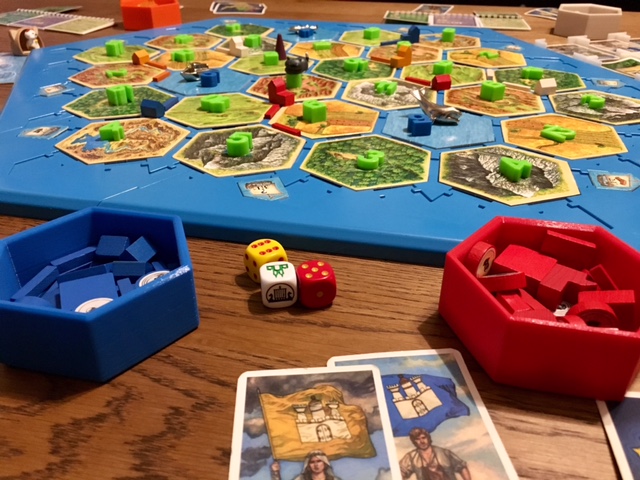

Catan cities and knights rules upgrade#
If the players upgrade each section all the way, they will eventually get a card no matter what number is rolled as long as the event die shows the color of that section of the city (one out of six).

If the number on the red die matches one of the number icons shown on their current level in that section of their city, the player draws a progress card from the matching deck. If the event die shows a city matching the color of one of the three sections of the cities, players check their calendar and the red die. After each player takes resources for the number shown on the two resource dice, they check the even die. On each turn, the player rolls the red, white, and event die. Three new progress card decks are added to the game - one for each section of the city, as well as an event die. Each time a section of the city is upgraded, one page in that section of the calendar is flipped - showing a picture of the upgrade and the improvement die numbers.Ĥ.) Progress Cards: The development cards and largest army victory point card are removed from the game, and one of the white dice is exchanged for a new red die. For example, a player can upgrade to the first politic level - the Town Hall, by paying one coin commodity to the bank.

Each of the three sections of the city (trade, politics, and science) can be upgraded several times by paying a certain amount of commodities. On the one side of each of the three sections of the calendar, the players can see all their building options and the costs of each - a great player aid! Players can also use cloth, coin, or paper to improve their cities. Still, another option (and another wooden piece!) is nice to have in the game.ģ.)Ĝity Improvements: At the beginning of the game, each player is given a flip booklet (calendar) to show their city improvements. I’ve seen some players center their strategies around walls, but never to any kind of game-breaking strategy. Walls are a nice feature but unless you’re hoarding cards, they’re not that big of a deal. Each city wall allows a player to increase their hand limit (when a robber is rolled) by two cards - to a maximum of eleven cards. These can be built on a player’s turn under one of their cities by paying two bricks. Commodities are used by players to upgrade their cities, and in most circumstances are treated like resources- can be traded, stolen, etc.Ģ.) Walls: Each player receives three square wooden blocks in their color at the beginning of the game.

When a city is next to a pasture, mountain, or forest, and the number on that hex is rolled, the player with the city gains cloth, coin, or paper instead of two of the basic resources. Here’s a listing of some of the changes.ġ.)Ĝommodities: Three more types of cards are included with the game - cloth, coin, and paper - known as commodities. But if you like the basic system of Settlers and would like to see it optimized and expanded, then Cities and Knights is your game. But I do realize that Cities and Knights is a huge change from the original Settlers, and I still revert back to the original game + Seafarers often. I am in the former group, thinking that the benefits of Cities and Knights are largely for those who desire a more complex game with various options. Others feel that the length and added rules actually detract from the game, dragging what was once a short, fun game into a dreary, endless experience. Some people welcome this change, as they feel “vanilla” Settlers is too simplistic, and this expansion adds the complexity that is needed. And the reason is quite simple - it makes the game quite a bit more complex, changing it entirely. Cities and Knights (Kosmos and Mayfair Games, 2000 - Klaus Teuber) is probably the most controversial of the Settlers of Catan expansion.


 0 kommentar(er)
0 kommentar(er)
